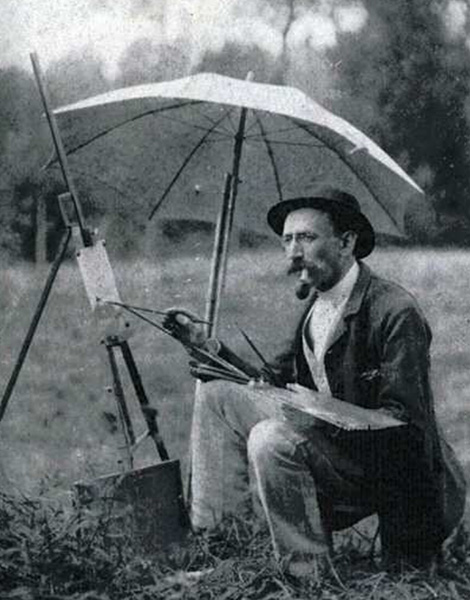Les meules, signées Eugène Jules DELAHOGUE
Les meules, signées Eugène Jules DELAHOGUE (Soissons, 1867- Nice, 1934)
Huile sur toile, signée en bas à gauche et datée 1901
Dimensions avec cadre 55×44 cm
Dimensions sans cadre 35×24 cm
Eugène Delahogue fut un peintre reconnu de la fin du 19ème siècle, spécialisé ainsi que son frère jumeau Alexis dans les scènes orientalistes. Ils exposaient ensemble étant membres de la Société des peintres Orientalistes, au Salon des Artistes Français dont ils furent tous deux sociétaires.
Ils habitèrent tous les deux le village de Blandy-les-Tours près de Fontainebleau en Seine-et-Marne et c’est tout naturellement qu’ils allaient peindre avec leurs vélos “spécialement équipés” dans les environs de la campagne Bellifontaine.
Notre tableau fut peint en novembre 1901, la date fut inscrite par le peintre sous sa signature, avec le bout dur de son pinceau, très précisément du 16 au 18 novembre puisque ceux sont les deux dates inscrites sous la signature du peintre. L’on peut s’imaginer deux jours d’observation en plein air, sur le motif, à scruter ces meules de foin sous la pâle lumière automnale d’un mois de Novembre. La sincérité rendue du sujet est très palpable dans ce tableau, où les qualités de notre peintre sont indéniables. Ainsi, les teintes violacées des fougères et celles assourdies de l’automne sont traitées en touches légères et lumineuses et la végétation semble résister à la chape hivernale en offrant de petits éclats de couleur au devant des meules.
Ses œuvres sont exposées aux Musées de Langres, Soissons et Louviers.
The haystacks, signed Eugène Jules DELAHOGUE (Soissons, 1867- Nice, 1934)
Oil on canvas signed bottom left and dated 1901
Dimensions with frame 22×17 inches
Dimensions without frame 14×9 1/2 inches
Eugène Delahogue was a well recognized artist at the end of the 19th century, specializing in orientalist scenes with his twin brother Alexis. They exhibited together as members of the Orientalist artists French Society, as well as the Salon des Artistes Français.
They both lived in the tiny village of Blandy-les-Tours, in the region of Fontainebleau and therefore they were naturally inspired with the plein-air nature around the beautiful countryside from the Seine-et-Marne region. From close people witnessing the life of these two artists, they had especially equipped their bikes to travel around with brushes, colors and easel.
Our painting was executed in 1901, the date of November 16-18 was registered with the bottom of his brush under the signature. Thus we can imagine two lovely and passionate days of plein-air artistic observation in the middle of the fall, reflecting and considering the pale light of the autumnal day enveloping those haystacks. The sincerity of the study is still palpable today, evident in our artwork and the light tones in the foreground are escaping from the coming muffled coat of winter, with little touches of purplish, yellow and light green brushstrokes in the fern vegetation. Eugène Delahogue was probably watching the unfolding of Impressionism in those days and certainly got inspired.
His works are showing in museums of Louviers, Langres and Soissons.





